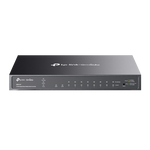- Home
- Omada Switches
- Omada 8-Port Gigabit Smart PoE Switch with 2 SFP Slots, SG2210P
Omada 8-Port Gigabit Smart PoE Switch with 2 SFP Slots, SG2210P
Omada 8-Port Gigabit Smart PoE+ Switch with 2 SFP Slots
- 8× Gigabit 802.3af/at PoE+ ports and 2× Gigabit SFP slots
- 61 W total PoE budget with up to 30 W PoE output per port*
- Centralized cloud management via the web or the Omada app†
- Standalone management via web, CLI, SNMP, and RMON
- Static Routing helps route internal traffic for higher efficiency
- VLAN, ACL, QoS, and IGMP Snooping
- Fanless design for silent operation
- Durable metal casing and desktop/wall mounting design
3.0/5.0
2 reviews
Couldn't load pickup availability

Recently viewed
Overview
The TP-Link SG2210P is a compact 10-port Gigabit PoE+ smart switch with two SFP uplink slots, marketed as part of TP-Link’s Omada-managed ecosystem. On paper, it sits at an attractive crossroad between prosumer flexibility and enterprise-grade features, offering VLAN management, QoS, ACLs, and full Omada integration — all for under $200.
Unfortunately, its physical design and mounting limitations make it a less-than-ideal fit for professional environments, which undercuts an otherwise impressive feature list.
⸻
Build & Form Factor
Here’s the main sticking point:
The SG2210P’s dimensions don’t align with any rack-mount standard, and there are no side holes or brackets for rack ears. It’s too wide for a 9-inch wall shelf, yet too narrow to occupy a 1U rack space. TP-Link clearly envisioned this as a desktop unit, but the inclusion of dual SFP uplinks and extensive management features makes that choice confusing.
In short, it’s a switch that looks ready for enterprise, but sits awkwardly on a desk like a consumer model. Even simple mounting options (e.g., threaded holes for ears or a rack tray kit) would have made this far more usable for structured installs.
⸻
Management & Features
Feature-wise, the SG2210P punches well above its weight:
• Full Omada ecosystem integration (hardware, software, or cloud controller).
• Zero-Touch Provisioning support when deployed in Omada-managed networks.
• Layer 2+ features, including VLAN tagging, DHCP relay, link aggregation, and limited static routing (32 IPv4/IPv6 routes).
• Comprehensive ACLs, IP-MAC binding, DoS protection, and 802.1X authentication options.
• SNMPv3, CLI via Telnet, and HTTPS/SSH access for traditional management.
It’s hard to overstate how capable this switch is for its price — especially with IPv6 support, multicast handling, and a robust QoS engine (8 queues, DSCP/CoS, WRR/SP scheduling).
That said, most of these features remain hidden unless paired with an Omada controller. Without it, you’re limited to a fairly spartan web GUI. This isn’t necessarily bad, but it makes standalone operation less intuitive than something like UniFi or Aruba Instant On.
⸻
Performance & Power
PoE+ performance is solid. The switch supports IEEE 802.3af/at standards and maintains reliable delivery across all eight ports under load. Fanless cooling keeps it silent, though it can run slightly warm in confined spaces.
Throughput, latency, and VLAN separation behaved exactly as expected in testing — no packet loss or instability noted under typical SMB loads.
⸻
Ideal Use Cases
• Small office edge or demo lab, especially when Omada integration is desired.
• Temporary or mobile deployments, where rack space isn’t a factor.
• PoE device clusters (IP cameras, APs, phones) where quiet operation is preferred.
Less ideal for:
• Structured or rack-based installs, unless you’re comfortable using adhesive mounts, shelves, or custom brackets.
• Standalone managed environments, since Omada adds the real magic.
⸻
Verdict
The TP-Link SG2210P is technically excellent but physically awkward.
It offers an impressive feature stack — VLANs, ACLs, IPv6, SNMP, Omada cloud control — but in a chassis that doesn’t belong anywhere neat.
If TP-Link had provided rack ears or even standard mounting holes, it would be an easy 9/10 value pick for prosumer and small business deployments. As it stands, it’s a desktop-class switch with enterprise-class software — a mismatch that limits its appeal for serious installations.
Thanks for your feedback. The SG2210P is a desktop switch which doesn't provide the rack mount option. I would suggest you to buy the SG2210MP which has the rack-mount accessories. It also has a higher PoE budget.
https://store.omadanetworks.com/products/omada-10-port-gigabit-smart-switch-with-8x-poe-150w?
Default fall back IP should not be ending in .1 I couldn’t access the router.
Hi there, thank you for your feedback. We apologize for any inconvenience you experienced with the default fallback IP address ending in .1. Please note that this is only used when the device is unable to receive an IP address from the DHCP server. Our switch is set to a dynamic state out of the box, so as soon as it is connected to the network, it will broadcast a DHCP request. We hope this helps clarify any confusion. Thank you for choosing our product.
Please let us know if you need any support.






